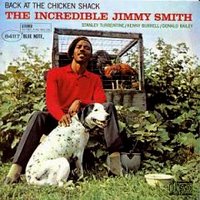Back At The Chicken Shack - Jimmy Smith

Just in case this album's name doesn't tip you off, Back At The Chicken Shack is some down-home, funky music. The title track opens with Jimmy Smith groovin on a mid tempo blues riff, taken at a perfect tempo to extract every last once of funk from the tune. Kenny Burrell follows Smith's understated solo with one of his own, keeping the vibe of this piece subdued, yet building slowly into Turrentine's sax solo. Stanley - who really shines on this record - maintains the slow, simmering groove without overdoing it. Chicken Shack epitomizes the funky, cool blues - and sets the stage for the rest of the record.
When I Grow Too Old To Dream begins in a similar vein, with Smith laying down a loping half-time bass line beneath Turrentine's comfortably laid-back statement of the melody. As Turrentine eases into his solo, we catch a few glimpses of a more expansive sound, as he builds through one bluesy chorus after another, opening up the sound of the groove. Smith's comping echoes the occasional soaring, searing held notes Turrentine works into at points, punctuating and shaping his solo. Jimmy's solos reel things back in a bit to a tighter groove, still steeped in down home blues. Turrentine returns for another taste after Smith's solo, again gradually pushing towards some more wailing, plaintive cries. Donald Bailey keeps pace with all of this without being in the least bit intrusive - moving between an easygoing swing and funkier back beats without missing a beat.
The pace picks up a few more notches, as Minor Chant begins simmering along. Turrentine's breathy first notes soon give way to more of the expansive tones we were teased with on Too Old To Dream - combined with Smith's percolating accompaniment beneath his solo, Chant is cookin along nicely by the time Stanley wraps his solo. Smith comes in right on it (he and Bailey tightening up the groove a bit again here) - venturing more into his faster, denser lines as his solo progresses. Smith manages to sustain a great ahead of the beat sense through this solo with his walking bass line sitting just ahead of Bailey's pulse.
Messy Bessie starts off similarly to Too Old To Dream - a down, halftime midtempo groove that opens up in to a relaxed swing with Turrentine's solo. Stanley's sounding very limbered up and fluid at this point - his solo marked by faster runs, still punctuated with fat, bluesy wails at just the right times to keep things interesting. Burrell jumps in afterwards with a well-constructed solo that progresses from sparing, blues-tinged phrases to some smokin lines and back again. Smith follows up with more of the same, and then some. Jimmy had a great knack for exploiting his instrument's character: Sitting on a single note through a whole chorus or more - either as a held note, or brilliantly placed rhythmic accents. Not to mention his use of chord-melody phrases - in the bluest thirds or sixths intervals you could hope to find for any given moment.
While generally showing a more laid-back side of his playing, Chicken Shack has all the classic elements of Smith's style - everything needed for a comprehensive course of study from Organist 101 up through a Phd. After all, he is humbly referred to on the LP's cover as "The Incredible Jimmy Smith" for a reason... If you're not convinced just listen to any jazz organist since (for that matter, take a listen to the prog-rock rambling of musicians as far afield as ELP - maybe Keith Emerson wasn't quite the innovator some thought...)
In many ways (at least for me), it's really Turrentine that makes this record - his playing acts as a perfect foil for Smith, playing off Jimmy's more in-the-pocket funk with a broader, bluesier wail - this interplay's what keeps me coming Back to The Chicken Shack, as it were. Stanley's playing on this album really captures the essence of the genre, and seems the most inspired playing in the session - what makes this more than just another hard-bop organ trio/quartet-type date, and a classic.
Back At The Chicken Shack (Blue Note BLP 4117)
Rudy Van Gelder Studio, Englewood Cliffs, NJ
April 25, 1960



1 comments:
World class...
Post a Comment